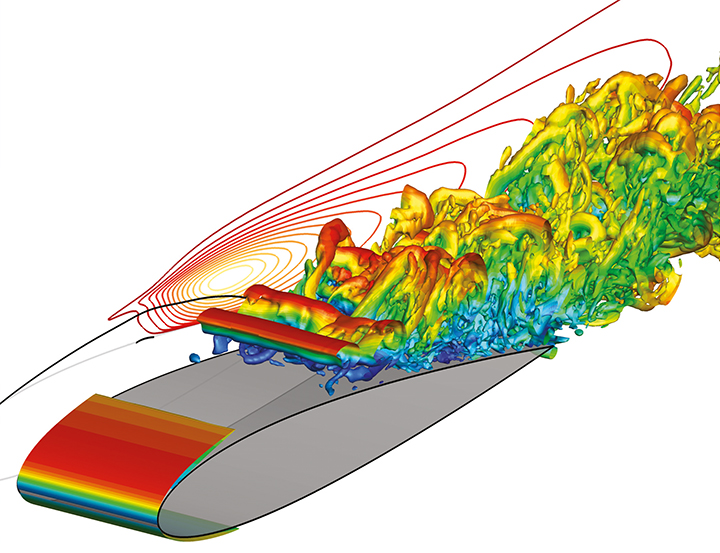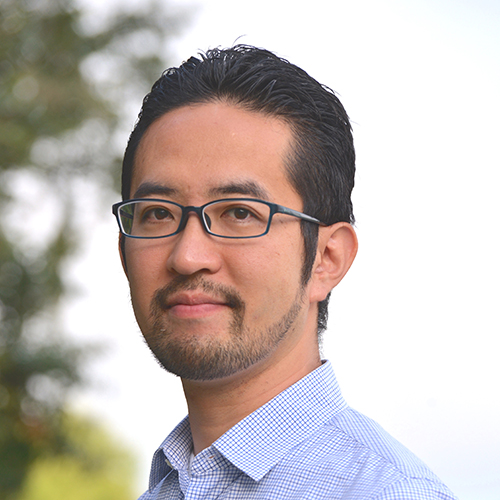UCLA MAE Associate Professor Sam Taira studies a variety of fluid mechanics problems with research interests in the areas of computational fluid dynamics, flow control, data science, network theory, and unsteady aerodynamics. Taira’s studies leverage numerical simulations performed on high-performance computers.
What are computational fluid dynamics (CFD) and what got you involved in researching them?
CFD is a subfield of fluid dynamics where we use computers to solve and analyze fluid dynamics problems. We use computer simulations to analyze the fluid flows. What that involves is to numerically solve the partial differential equations (the Navier-Stokes equations) to get some meaningful physics. There are skillsets and computational resources needed to simulate fluids flows.
As for what got me involved, I was interested in Aerospace Engineering and Mathematics as an undergraduate student. I double-majored in those fields. I was particularly interested in fluid mechanics and sought to combine the two fields for my graduate studies. That’s how I got into CFD.
How does CFD impact our daily lives?
Traditionally, most of the design process for various engineering systems that operate in fluids (fluids involve air, water, any kind of liquid or gas) was done through experiments. Nowadays, computational analyses and simulations also play key roles in the design process. Imagine the design of an aircraft; aerodynamics is a key component for product development. CFD serves as a critical component of the design process to find out a lot of information about the design, including efficiency, safety, and agility. In some cases, numerical simulations play a larger portion of the analysis than experiments. That is the direct impact from CFD on the product designs that we see.
Is the general process to build a model in a computer first and then test it there, to save on costs?
I’m a big believer in having the experimental counterpart for this design process as well; they go hand-in-hand. Computational analysis can provide, usually, more information that what the experiments can measure. The full validation must be performed with a physical system, such as flight tests for an aircraft.
Or a heart valve?
Same with that; you do the simulation and see if the design will work, and then you have to test it with a real system. It’s an iterative process between the simulation and experiment. In my opinion, I don’t think you can cut out one or the other. It’s a packaged, complementary process.

What is network-based modelling and control of unsteady flows?
One of the things we do in our group is to examine the interactions that take place within a complex fluid flow. In fluid mechanics or any kind of physical problem, there are linear problems and there are non-linear problems. Linear problems are fairly easy to handle, and non-linear problems are difficult because you have nonlinear interactions. The idea here is to use ideas from network analysis to quantify interactions in a very elegant way. The use of network science is novel in fluid mechanics. What we want to do, is extend those tools that you are starting to see, from applied math or network science to fluid mechanics, and come up with new models that could describe fluid flows. Once we have these models developed, we can perform feedback control to alter the behavior of fluid flows to achieve engineering benefits.
It’s very intuitive in some sense. For example, we made analogies between an airline network and the interaction that takes place in turbulence. When you look at turbulence, it’s a very chaotic multi-scale nonlinear problem. But you can make analogies to something like an airline network. In an airline network, you have small airports and major hubs. You can easily imagine which airports are important to the daily operation of airlines. If you dump a lot of snow at some of the smaller airports, the operations are not going to be affected significantly, but if you dump a lot of snow at a hub, then you can see that that airline (or passengers) is going to have a tremendous amount of issues. The same can be said about fluid flows. If you were to perturb a certain part of the flow that acts as a hub, then you can imagine something drastic is going to happen to that fluid flow, so we are trying to exploit what we know from network science and see if we can understand fluid flow in an intuitive way.
What have you discovered in your research into “Low-Re Compressible Flows” and Low-Re flight in the Martian atmosphere?
This is interesting. This is a collaboration with our Japanese collaborators at Tohoku University. Traditionally, we associated compressible flow with high-speed flow, and that’s on Earth. But if you want to fly an aircraft on Mars, it turns out you will have low speed flow with compressibility due to the atmospheric conditions on Mars, and that’s a regime that we traditionally have not studied in aerospace science. We have looked into that quite a bit to see what kind of difference we would see in aerodynamics around canonical airfoils and blunt bodies. There are some interesting things that we have never seen before. This kind of aerodynamics has not been explored much yet.
What would these aircrafts look like flying through the Martian atmosphere?
They would look like what drones look like on Earth, but some of the components would have different designs—for example, different types of airfoils.
When you assemble members for your lab team, what are you looking for in the students?
I look for students who are not shy about incorporating new ideas into a traditional area. Our group is interested in using various tools from applied math, control theory, physics, and data science to tackle some of the toughest problems in fluid mechanics. I look for candidates who are eager to get their hands on new mathematical tools and try them out in fluid mechanics. Another thing I look for is the level of interest that the student has; I think for any student or post-doc who decides to devote their twenties to studying, you really have to have the passion to do so. Those are the types of traits I look for in any student or post-doc that is interested in joining my group. Simply put: You’ve got to love what you’re doing.
You have also done educational outreach. Can you tell us about “Oobleck”?
This is something I did at my previous place where we went to a few elementary schools to teach students about what fluids are through flight or by playing with various types of fluids – and one of them was Oobleck. You can make Oobleck by mixing water and cornstarch. It behaves in a funny way; it’s a non-Newtonian fluid, it looks like it’s flowing but if you apply a lot of stress, it hardens up like a solid. It’s a great educational tool to make young, aspiring scientists think of what fluids and solids are. You can also quiz them on how that kind of material can be useful. It’s a nice educational outreach activity we have done.
We also do outreach/educational activities through our professional society at AIAA (American Institute of Aeronautics and Astronautics). I used to run what we call a “discussion group” where we would have community discussions and try to put together a lot of educational materials. Those efforts have led to the creation of two good-size overview papers. These are the sort of things I love getting involved in.
I have also organized workshops to enhance collaboration and communication between different fields. One of the most memorable workshops was the one I organized last year in Tokyo between the US and Japan to bridge Data Science and Fluid Mechanics. That was not only super-productive but also a lot of fun. Recently, I have been invited to serve as a keynote lecturer by ERCOFTAC’s workshop to teach Network Science for Fluid Dynamics in Montestigliano, Italy. I am really looking forward to this workshop to interact with talented researchers to solve some challenging problems.
What’s your experience been like at UCLA now that you have joined the MAE faculty?
It’s been super-exciting. I wake up every morning and I look forward to getting to work. I enjoy the stimulating discussions I have with my colleagues, students, postdocs, and visitors (we get a lot of them!). I enjoy every minute of it, and I look forward to advancing the capabilities of our research group and seeing what kind of challenges we can take on and hopefully solve.

